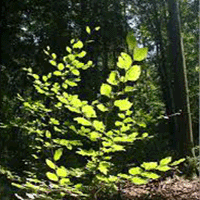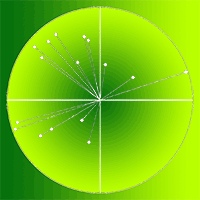
Assessment of sanitary conditions in stands of Norway spruce (Picea abies Karst.) damaged by spruce bud scale (Physokermes piceae Schrnk.)
O Miezite , M Okmanis, A Indriksons, J Ruba, K Polmanis, L Freimane
iForest - Biogeosciences and Forestry, Volume 6, Issue 2, Pages 73-78 (2013)
doi: https://doi.org/10.3832/ifor0703-006
Published: Feb 07, 2013 - Copyright © 2013 SISEF
Research Articles
Collection/Special Issue: IUFRO 7.01.00 - COST Action FP0903, Kaunas (Lithuania - 2012)
Biological Reactions of Forest to Climate Change and Air Pollution
Guest Editors: Elena Paoletti, Andrzej Bytnerowicz, Algirdas Augustaitis
Abstract
Spruce bud scale (Physokermes piceae Schrnk.) affects tree growth directly and indirectly. Direct injury appears in the form of tissue damage, as insects suck sap from tree phloem. Indirect injury appears as “honeydew”, which results in negative effects on tree growth. Plant sap is saturated with various carbohydrates called photosynthates that are difficult for scaly insects to digest. Therefore it is secreted in excrements, which are subsequently a food source for the black sooty mold (Apiosporium pinophilum Fuckel). The fungus covers needles blocking stomata, causing decreased transpiration and photosynthesis. An inexplicable wither of Norway spruce was reported in Latvia during 2010 due to black sooty mold. However, spruce bud scale was not evident. In 2011, mass propagation of spruce bud scale was observed following the 2010 Norway spruce loss. One objective of this research was to determine if Kraft tree growth classes could be applied to establish the factors responsible for tree foliage damage. Six 21 - 40 year old (second age class) Norway spruce stands were evaluated. Two circular sample plots with a 7.98 m radius, and a 200-m2 area were randomly established per each forest stand hectare. Diameter at breast height (dbh, 1.3 m), and height of approximately 30 trees was measured to model a trend. For all trees, Kraft class, and foliage damage level caused by spruce bud scale and black sooty mold were determined. Significant differences were not observed in tree damage levels among stands, however significant differences among damage levels in different Kraft classes were detected (F = 3.45 > Fcrit. = 2.80, α = 0.05 > P = 0.02) found. Overall damage intensity was 29.3 %. Total forestry loss was 1153 LVL (1640 EUR) for all surveyed stands (10 ha), and 115 LVL (164 EUR) per hectare.
Keywords
Norway spruce, Spruce bud scale, Kraft’s classes, Damage intensity, Economical losses
Authors’ Info
Authors’ address
M Okmanis
A Indriksons
J Ruba
K Polmanis
L Freimane
Latvia University of Agriculture, Forest Faculty, Jelgava (Latvia)
Corresponding author
Paper Info
Citation
Miezite O, Okmanis M, Indriksons A, Ruba J, Polmanis K, Freimane L (2013). Assessment of sanitary conditions in stands of Norway spruce (Picea abies Karst.) damaged by spruce bud scale (Physokermes piceae Schrnk.). iForest 6: 73-78. - doi: 10.3832/ifor0703-006
Academic Editor
Alberto Santini
Paper history
Received: Jul 24, 2012
Accepted: Dec 03, 2012
First online: Feb 07, 2013
Publication Date: Apr 02, 2013
Publication Time: 2.20 months
Copyright Information
© SISEF - The Italian Society of Silviculture and Forest Ecology 2013
Open Access
This article is distributed under the terms of the Creative Commons Attribution-Non Commercial 4.0 International (https://creativecommons.org/licenses/by-nc/4.0/), which permits unrestricted use, distribution, and reproduction in any medium, provided you give appropriate credit to the original author(s) and the source, provide a link to the Creative Commons license, and indicate if changes were made.
Web Metrics
Breakdown by View Type
Article Usage
Total Article Views: 59735
(from publication date up to now)
Breakdown by View Type
HTML Page Views: 49526
Abstract Page Views: 3951
PDF Downloads: 4440
Citation/Reference Downloads: 17
XML Downloads: 1801
Web Metrics
Days since publication: 4691
Overall contacts: 59735
Avg. contacts per week: 89.14
Citation Metrics
Article Citations
Article citations are based on data periodically collected from the Clarivate Web of Science web site
(last update: Mar 2025)
Total number of cites (since 2013): 18
Average cites per year: 1.38
Publication Metrics
by Dimensions ©
Articles citing this article
List of the papers citing this article based on CrossRef Cited-by.
References
Statistic economics. Work with SPSS an Microsoft Excel. Datorzinibu centrs, Riga, pp. 352. [In Latvian]
Gscholar
The theorethical ground of risk management. LLU Raksti 6 (301): 52-63. [In Latvian]
Gscholar
Dürchforstungen, Schlagstellungen und Lichtungshieben. Beitrage zur Lehre. Klindworth’s Verlag, Hannover, Germany. [in German]
Gscholar
Evaluation of reasons of spruce damages on drained soils in SIA “Rigas mezi”. Project report. LVMI Silava, Salaspils, Latvia, pp. 56. [In Latvian]
Gscholar
The assessment of the reasons of large scale damage of spruce stands and the elaboration of reccomendations for the management of damaged stands in the forests of Joint Stock Company “Latvian State Forests”. Project report, LVMI “Silava”, Salaspils, Latvia, pp. 145. [in Latvian]
Online | Gscholar
Characterizations of severe damages of spruce (Picea abies Karst.) stands in relation to soil properties. In: Proceedings of the “Research for rural development 2011. Annual 17th international scientific conference”. Jelgava, LUA, Latvia, pp. 22-28.
Online | Gscholar
Atlas of insect pests of forest trees. State Agricultural Publishing House, Prague, pp. 126. [In Russian]
Gscholar
Insects living on spruce and pine in Latvia’s forests, Zinatne, Riga, pp. 208. [In Latvian]
Gscholar
Scale insects Coccodea. Latvia’s nature. Latvia’s Encyclopedia, vol. 1, Preses nams, Riga, pp. 171. [In Latvian]
Gscholar
Pests of trees and shrubs in green plantations of the Latvian SSR. In: “Pests of trees and shrubs in the green areas of the Latvian SSR”. Zinatne, Riga, Latvia, pp. 264. [in Latvian]
Gscholar
World crop pests. Soft scale insects. Elsevier Science, Amsterdam, The Netherlands.
Gscholar
Spruce bud scale insect (Physokermes piceae Schrnk.). [In Lithuanian]
Gscholar
Biological aspects of Spruce Bud Scale (Physokermes piceae Schrnk. - Hemiptera: Coccidae). Tarim Bilimleri Dergisi 12, pp. 44-50. [In Turkish]
Gscholar

















